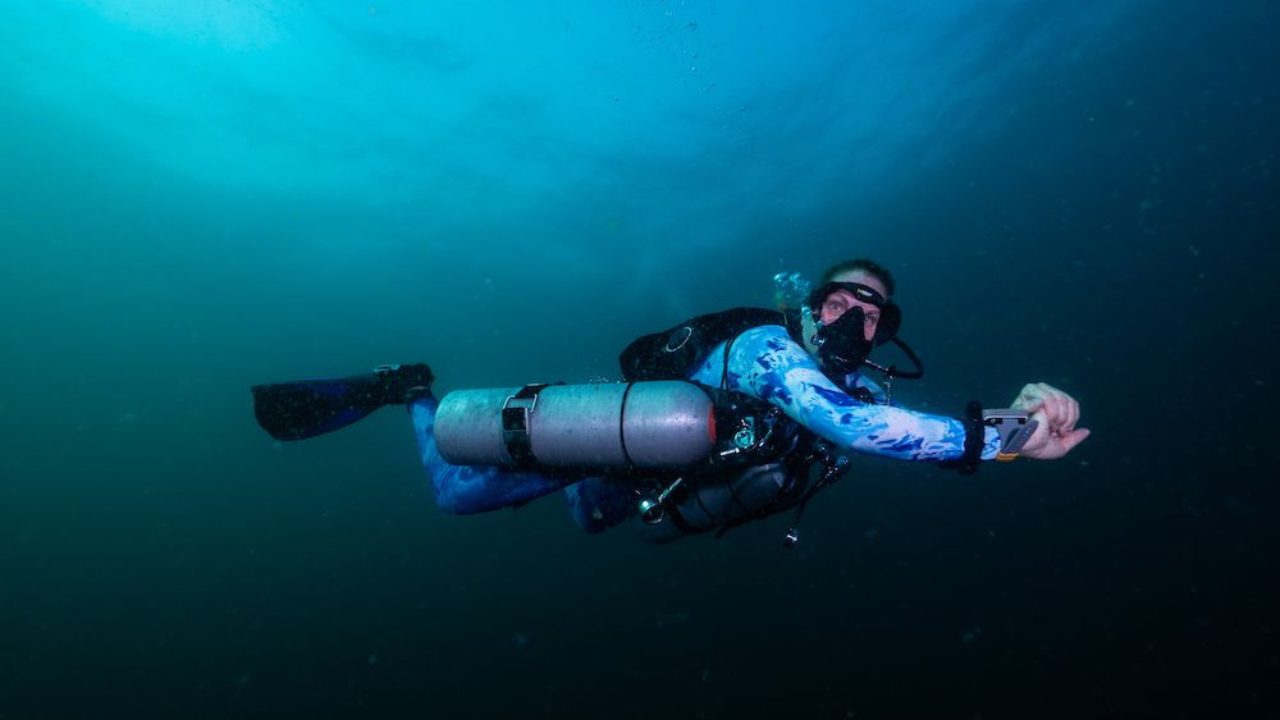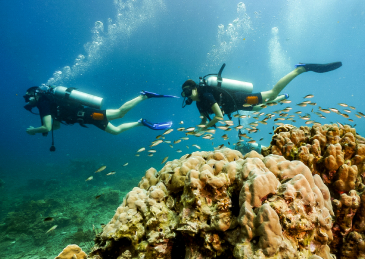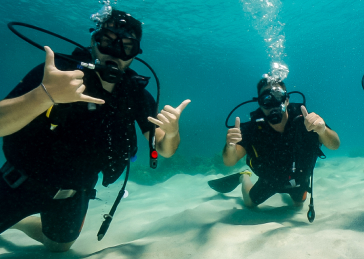Best Sidemount Diving Koh Tao: Dive Koh Tao Confidently As A Sidemount Diver
Por Bryan Roseman
Modified 9th June 2025
Best Sidemount Diving Koh Tao: Complete Guide & Tips for Technical Divers
Sidemount diving represents a significant evolution in technical diving, offering enhanced flexibility, improved safety margins, and extended bottom times compared to traditional back-mounted configurations. For divers seeking to advance their technical skills, Koh Tao provides an unparalleled combination of training facilities, diverse dive sites, and optimal conditions for mastering this specialized diving technique.

Why Koh Tao is Perfect for Sidemount Technical Diving
Koh Tao’s reputation as a world-class diving destination extends far beyond basic certification courses. The island’s unique geographic position in the Gulf of Thailand creates ideal conditions for technical diving advancement, particularly for sidemount configurations.
The combination of calm, clear waters with visibility often exceeding 25 meters, diverse marine ecosystems, and challenging technical dive sites makes Koh Tao an exceptional training ground for sidemount diving. Professional dive centers like La Bombona Diving offer comprehensive technical training programs with experienced instructors who specialize in advanced diving techniques.
Optimal Training Conditions
Koh Tao’s protected waters provide consistent diving conditions throughout most of the year, allowing for focused skill development without the variables of challenging surface conditions. The island’s numerous shallow practice sites enable thorough equipment familiarization before progressing to deeper, more technical environments.
Essential Sidemount Diving Benefits
Sidemount configuration eliminates back-mounted tanks, providing unrestricted movement through tight spaces, caves, and wreck penetrations. This positioning allows for superior trim control and natural swimming posture.
Carrying two independent air supplies with separate regulators provides complete redundancy. Each tank can be monitored individually, and gas management becomes more precise and controlled.
Dual tank configuration provides substantially more breathing gas, enabling longer exploration times on technical dives and reducing surface intervals between multiple dive sequences.
Lower center of gravity and balanced tank positioning creates exceptional stability and precise buoyancy control, essential for technical diving environments requiring exact positioning.
Complete Sidemount Equipment Configuration
Harness and Buoyancy System
- Specialized sidemount harness with adjustable tank attachment points
- Low-profile BCD designed for sidemount configuration
- Proper weight distribution system
- Backup buoyancy devices for technical diving
Breathing Systems
- Two complete regulator sets with environmental sealing
- Long hose configuration (2.1m/7ft primary regulator)
- Backup regulator with standard hose length
- Regulator switching blocks for gas management
Tank Configuration
- Aluminum or steel tanks appropriate for dive requirements
- Tank attachment hardware (bungee cords, clips)
- Tank valve shutoff procedures and accessibility
- Proper tank marking and gas identification
Navigation and Safety
- Advanced dive computer with multi-gas capability
- Backup depth gauge and timer
- Underwater communication devices
- Emergency signaling equipment

Premier Sidemount Diving Locations in Koh Tao
Koh Tao’s most famous technical dive site features towering granite pinnacles covered in colorful soft corals. Multiple swim-throughs and caverns provide excellent sidemount training opportunities, while large pelagic species including whale sharks frequent the area.
Best for: Intermediate to advanced sidemount training, navigation practice, and marine life observation.
Multiple submerged pinnacles rising from sandy bottom create a complex three-dimensional diving environment. Excellent for practicing advanced buoyancy control and precise positioning required in sidemount configuration.
Best for: Skill development, underwater photography, and extended bottom time practice.
Varied topography with both shallow coral gardens and deeper sections provides excellent progression opportunities for sidemount divers. Protected location offers consistent conditions for technical skill development.
Best for: Equipment familiarization, basic sidemount techniques, and controlled environment training.
Considered the Gulf of Thailand’s premier dive site, featuring the famous “Chimney” swim-through. Advanced sidemount divers can safely navigate this vertical passage while experiencing world-class marine biodiversity.
Best for: Advanced sidemount techniques, penetration diving, and challenging navigation scenarios.
Mastering Sidemount Challenges
Sidemount diving presents unique challenges that require dedicated practice and proper instruction. Understanding these challenges beforehand enables more effective skill development and safer diving practices.
Buoyancy Control Mastery
Sidemount configuration significantly alters center of gravity and buoyancy characteristics compared to traditional back-mounted systems. The lateral tank positioning requires precise weight distribution and trim adjustments to achieve optimal underwater positioning.
Master basic hovering and trim before progressing to open water environments.
Fine-tune weight distribution through multiple practice sessions rather than dramatic changes.
Maintain consistent tank placement throughout the dive for predictable buoyancy characteristics.
Develop awareness of how breathing affects buoyancy in sidemount configuration.
Streamlining and Efficiency
Achieving proper streamlining in sidemount configuration requires attention to equipment positioning, body posture, and movement techniques. Proper streamlining reduces drag, conserves energy, and improves overall diving efficiency.
| Streamlining Element | Proper Technique | Common Mistakes | Impact on Performance |
|---|---|---|---|
| Tank Position | Parallel to body, secure attachment | Loose tanks, improper angle | Reduces drag, improves stability |
| Hose Management | Secured close to body | Dangling hoses, poor routing | Prevents entanglement, cleaner profile |
| Body Position | Horizontal trim, relaxed posture | Head-up position, tense muscles | Efficient movement, reduced fatigue |
| Fin Technique | Controlled, precise movements | Excessive finning, poor timing | Better propulsion, less disturbance |
Gas Management in Sidemount Diving
Effective gas management becomes more complex in sidemount configuration due to dual tank systems. Proper planning and execution ensure adequate gas supply throughout the dive while maintaining balanced buoyancy characteristics.
Strategic Gas Planning
- Pre-dive calculations: Plan gas consumption based on dive profile, depth, and duration
- Tank rotation schedule: Establish regular switching intervals to maintain balance
- Reserve gas management: Maintain adequate reserves in both tanks for emergency ascent
- Pressure monitoring: Regularly check both tanks throughout the dive
Post-Dive Procedures and Equipment Care
Proper post-dive procedures ensure both diver safety and equipment longevity. Sidemount equipment requires specific care protocols due to its complexity and critical safety functions. Understanding marine conservation practices is also essential for responsible technical diving.
Equipment Maintenance
- Thorough freshwater rinse of all components
- Complete drying before storage to prevent corrosion
- Regular inspection of harness webbing and hardware
- Regulator service according to manufacturer specifications
- Tank visual inspection and hydrostatic testing schedules
Health and Safety Monitoring
Post-dive health monitoring becomes especially important in technical diving scenarios. Watch for signs of decompression stress, equipment-related pressure points, and overall physical condition after extended bottom times.
Ready to advance your technical diving skills with the best sidemount diving Koh Tao has to offer?
La Bombona Diving specializes in advanced technical diving education, offering comprehensive sidemount courses with experienced instructors and state-of-the-art equipment. Getting to Koh Tao is easier than ever with our comprehensive travel guide from anywhere in Thailand.
- RAID certified sidemount specialty courses
- Expert technical diving instructors
- Complete equipment configuration training
- Access to premier technical dive sites
- Small class sizes for personalized instruction
- Advanced safety protocols and emergency procedures
- Professional equipment maintenance and support
- Flexible scheduling for intensive training programs
Advanced Explorer Course: ฿10,000 – 5 dives including day and night diving over 2 days
Start Your Advanced Training TodayProfessional instruction | All equipment included | RAID certification available
Preguntas frecuentes
Bucea con LBD: tu puerta a la exploración submarina
Tanto si eres un principiante curioso como un profesional experimentado, nuestra escuela es tu portal a las maravillas del submarinismo. Únete a nosotros en el mundo bajo las olas.
¿LISTO PARA EMPEZAR?
Consulta nuestros cursos de buceo en Koh Tao



